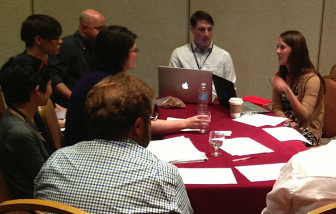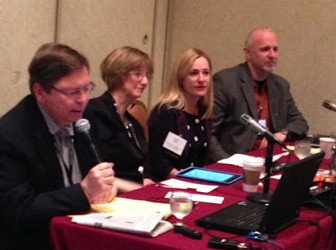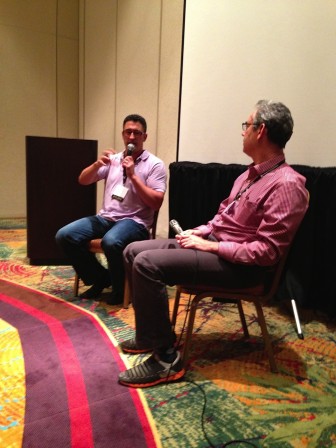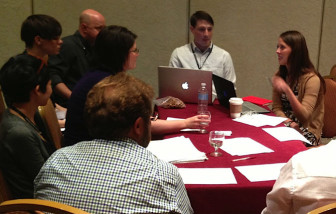
Lauren Fuhrmann of the Wisconsin Center for Investigative Journalism leads a breakout group on "Evaluation in a Box."" credit="
For the third year running, the Investigative News Network created a thriving space for nonprofit-news connections and advancement at the Investigative Reporters and Editors annual conference.
INN @ IRE Day 2013 ran from 8 a.m. to 6 p.m. on June 20, and delivered a full slate of practical and thought-provoking panels, workshops and breakout groups to 65 pre-registered attendees, and several dozen walkups. Attendees quizzed representatives from Google and the Knight Foundation, learned best practices from their peers at other INN member organizations, and networked enthusiastically during the 15-minute break periods between presentations.
INN's programming stood out for its focus on the emerging nonprofit-news sector, taking its place at the conference alongside big names of commercial journalism, such as Gannett and Scripps.
The day's events opened with a conversation between foundation program officers on the promise and challenges of journalism philanthropy, and offering insight on each foundation's distinct funding strategy.
Marie Gilot of the Knight Foundation observed that since they "can't re-fund lost journalism jobs," Knight's focus is on innovation, new processes and new tools. Sue Hale of the Ethics and Excellence in Journalism Foundation said that given the foundation's limits on long-term grantmaking, she welcomed proposals for year-long sustainability strategies. McCormick Foundation's Mark Hallet said that his program focus was "investing in audiences" due to community disenfranchisement from civic process.

From left: Charles Lewis, Sue Hale (Ethics & Excellence in Journalism Foundation), Marie Gilot (Knight Foundation), and Mark Hallet (McCormick Foundation)." credit="
All three advised grant seekers to reach out and get feedback before pitching, and to submit clean and proofread materials. They said the most competitive proposals could also demonstrate significant audience numbers, as well as partnerships and matching gifts.
Anticipating a theme that would recur throughout the day, Knight Foundation's Gilot also urged INN members to "experiment with revenue streams like you experiment with journalism."
Recognizing the limitations of major philanthropy, some INN members were aggressively developing additional revenue streams. In a best-practices lightning round, Joe Bergantino of the New England Center for Investigative Journalism said that his organization made between $4,000-$5,000 per month selling its news content to commercial news outlets. He also said 40 percent of the Center's revenue from journalism-training programs offered to students and the general public. Those same training programs also turned out to be great pipelines for interns and student-journalism projects.
Trevor Aaronson of the Florida Center for Investigative Reporting led a well-received session on on monetizing data, and Brad Racine from Investigative Newsource explored ways to develop news programming for public broadcasting ("Every news project should be reported and designed for radio, TV and the Web"). David Kaplan from the Global Investigative Journalism Network exhorted INN members to give world news a place in their local reporting. "All our stories are globalized today — from the food you eat to the toys your kids play with," he said. Pamela Dempsey of the Midwest Center for Investigative Reporting made the case for agribusiness as a subject of collaborative investigations, reminding attendees of "all those government billions flowing into Big Ag."
Following the lunchtime mixer, INN Chair Brant Houston led a conversation about mergers in the nonprofit news world, and the issue of maintaining journalistic independence in a news economy that has encouraged some major nonprofit nuptials. A notable example is the acquisition of I-News Network by Rocky Mountain Public Broadcasting, a marriage that increased the former's reporting resources and access to audiences, and boosted the latter's investigative muscle.
Other peer-led workshops dug into collaborative data reporting, building one's brand to build a base of donating members, and methods for evaluating journalism impacts.

Google's David Gehring (left) talks with an attendee." credit="
The afternoon closed with a conversation between INN CEO Kevin Davis and David Gehring, Google's Director of News Strategy and Partnerships. The two explored not just how journalists can make the most of Google's services and resources, but also broader issues of audience engagement and journalism's opportunity in the digital economy.
In particular, Gehring said, the greater degree of engagement a journalist has with the audience, the higher quality their relationship will be. He said journalists should learn from news and culture outlets such as Vice and Buzzfeed, which reap dividends from audience engagement. He also asserted that the specialized value journalists provide will be recognized by specialized audiences seeking hard-to-find information, creating fertile ground for traditional journalism ethics in the digital economy.
